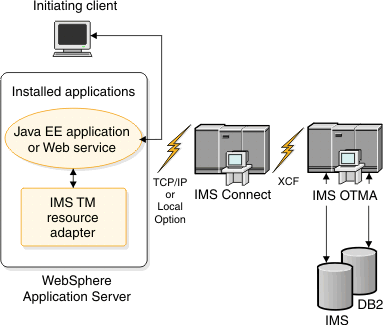Runtime process of the IMS TM resource adapter
The communication between the IMS TM resource adapter and IMS are through IMS Connect, which communicates with IMS Open Transaction Manager Access (OTMA).
When an initiating client (a Java™ application or a web service) issues a request to access an IMS transaction, the IMS TM resource adapter communicates with IMS Connect through TCP/IP or Local Option connections. IMS Connect then sends the transaction request to IMS OTMA by using the cross-system coupling facility (XCF), and the transaction runs in IMS. The response is returned to the Java application using the same path.
When an IMS application invokes an external enterprise JavaBeans (EJB) component, message-driven bean (MDB), or web service (also known as the IMS callout function), the callout requests from IMS applications are placed in the IMS OTMA hold queue. The Java application in WebSphere® Application Server is set up to start and obtain a connection to IMS Connect through the IMS TM resource adapter. The IMS TM resource adapter polls IMS Connect to retrieve the callout requests from the hold queue. The Java application processes the request, and returns any response data to IMS by issuing a normal IMS transaction request. The response might be returned in the same transaction or a different transaction, depending on whether IMS application issued a synchronous or asynchronous callout request.
